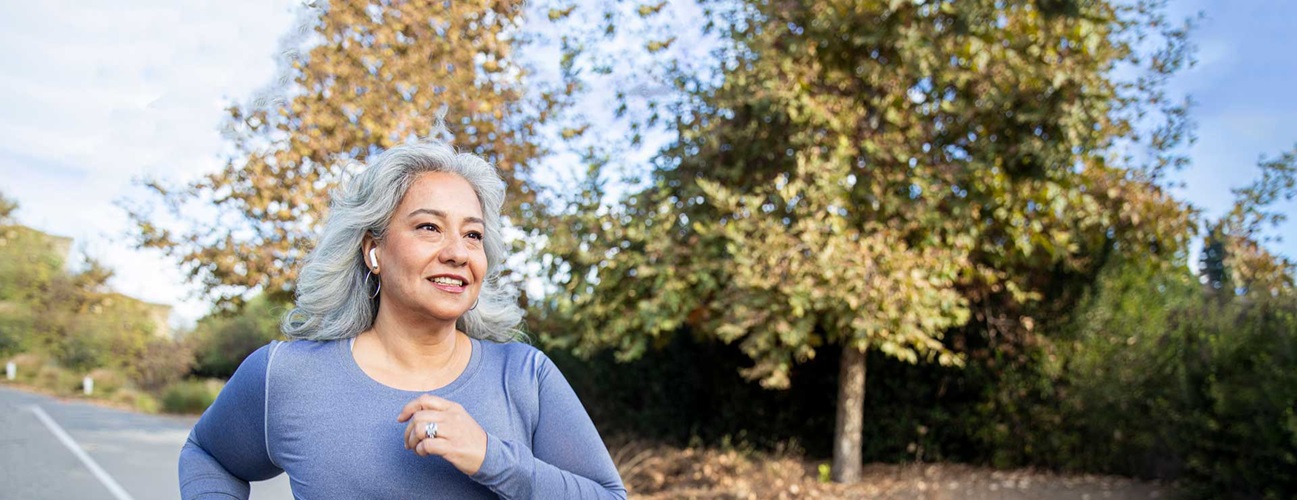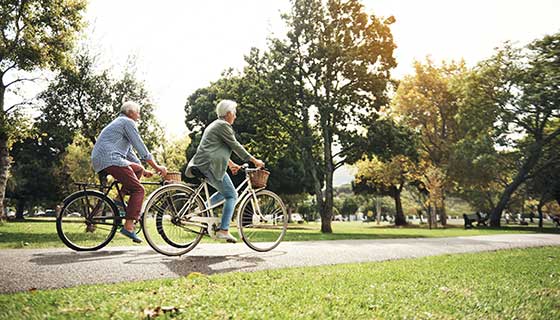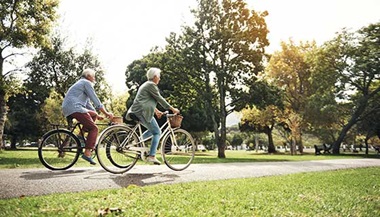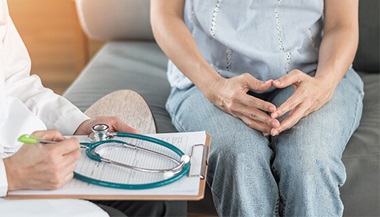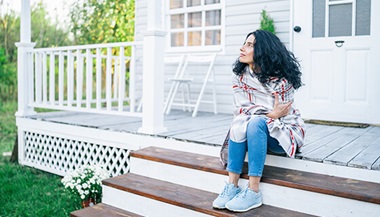Sports and Exercise Tips for Women Over 55 from a Sports Medicine Expert
Featured Expert:
Staying active is a big factor in healthy aging for women. Regular exercise can help lower the risk of chronic disease, prevent falls and ward off the weight gain and loss of bone and muscle mass associated with menopause.
Alexis Coslick, D.O., a sports medicine and rehabilitation expert at Johns Hopkins Howard County Medical Center, has tips for older women who are ready to play sports and get more physically fit — but want to avoid common sports injuries.
Fitness Benefits for Older Women
Playing sports and staying active benefit women 55 and older in many ways, says Coslick, including:
- Increasing calorie burning to support weight control
- Lowering the risk of chronic illnesses such as heart disease
- Decreasing muscle loss
- Strengthening muscles and bones
- Supporting sleep, cognition and mood
- Improving independence
- Connecting with others
- Extending lifespan
Even with all these benefits, not all women are taking advantage. If you’re starting a fitness program for the first time, you’re not alone. In fact, according to Coslick, 25% of women are not physically active. “Worse, of those in their 50s and 60s, only 30% are meeting aerobic training recommendations and only 6% meet strength training recommendations,” she says.
What kind of sports and exercise are best for older women?
Coslick says women 55 and up should enjoy a range of different activities to cover aerobic, strength and balance training. She emphasizes working on all three of these fitness aspects since they each benefit aging bodies in different ― and essential ― ways.
After checking with your doctor to ensure sports and exercise are safe for you, take a look at these suggested guidelines and get ready to get moving.
Aerobic Exercise
Aerobic exercise gets your heartbeat going and over time can help improve heart health and burn fat.
To get in a good aerobic workout safely, work with a doctor or fitness expert to calculate your maximum heart rate and a target heart rate based on your age and fitness level. Stay in your heart rate range and don’t overdo it. Also, be sure to invest in supportive shoes appropriate for each activity.
You can get a good aerobic workout by engaging in activities such as:
- Bike riding
- Running
- Pickleball
- Softball
- Dancing
- Walking
- Swimming
- Group aerobics, including water aerobics
Interval training is a type of exercise regimen that alternates timed segments of high intensity and low intensity exercise to improve heart health and increase stamina.
High-intensity interval training (HIIT) is an example that improves weight and fat loss, blood pressure and insulin sensitivity, Coslick says. The goal is to significantly raise the heart rate for several minutes, alternating with short periods of less strenuous exercise.
For example, you might exercise vigorously (running, cycling, rowing, weightlifting) for five seconds to eight minutes, working up to 80% of your maximum heart rate. Then, for the same time duration, you would exercise at an easier level, with your heartbeat at about 40% to 50% of your maximum. For an HIIT workout, you would alternate timed segments of vigorous and less-intense exercise for a total of 20 to 60 minutes.
Strength Exercises
Strength training involves moving against resistance. Here are some examples:
- Working out with free weights or resistance bands
- Using weight machines at the gym
- Using your own body weight, for example doing pushups, squats, lunges and crunches
Strength training can benefit women in their 50s, 60s and beyond. “Muscle and bone loss increase rapidly in women after menopause due to decreased estrogen,” Coslick explains, adding that the decline of muscle and bone mass in men is much slower.
Decreased muscle mass can cause an unhealthy cycle, slowing down fat burning. “Accumulating fat can increase the body’s inflammatory response and aggravate arthritis and other chronic conditions that make it harder to exercise,” she says.
Conversely, building muscle strength enables you to get more physically active and stay that way. Strong muscles support bones, protect joints and help you maintain balance. “Regular strength exercise can actually prevent you from becoming disabled,” Coslick says.
For example, she notes specifically that women who maintain strength in the glute muscles of the hips and buttocks with weight training, lunges and squats can help ward off bursitis of the hip.
Balance Exercises
Balance problems, including vestibular balance disorder, are more common in older adults. Medications can have dizziness or vertigo as a side effect. But Coslick notes that training can help minimize unsteadiness and make it safer for you to walk, exercise and avoid falls.
To build your balance, Coslick says, “Practice standing on one leg, or on both legs with your eyes closed. To make sure you do this daily try brushing your teeth while standing on one leg.”
Here are some more balance exercises to prevent falls.
Sports Injuries in Women 55 and Older and Tips to Prevent Them
Older bodies are more likely to have stiff tendons, decreased strength and reduced range of motion. All these can contribute to injuries such as back strain, sprains and muscle and tendon injuries.
Falls and Fractures
Falls are a major health risk for people as they age, especially women with thinning bones. One bad fall can put an older adult on the bench for weeks, months or even permanently.
“Women are more likely than men to develop osteoporosis, making brittle bones and fractures a real concern,” Coslick says, adding that wrist injuries and facial trauma are particularly common in older adults who fall.
Heat-related Illness
“Heat illness such as heat cramps, heat exhaustion and heat stroke are very common since older people cannot regulate internal temperature as easily as younger adults,” Coslick says. “Staying hydrated is essential, especially when playing sports outdoors in warm weather.”
Knee Issues
“Women are particularly vulnerable to knee injuries such as cartilage or ligament tears. This is because their hips are wider, which creates a different angle of stress on the knee during physical activity,” she explains. “Make sure you warm up beforehand and wear the right kinds of shoes for the sport you’re playing.”
Achieving and maintaining a healthy weight can also reduce stress on the knees and lower risk of torn cartilage and other painful conditions.
Other Tips for Preventing Sports Injuries
A little preparation can lower your chances of getting hurt when you exercise. Coslick recommends:
- Ensuring any equipment you’re using works properly
- Wearing appropriate, well-fitting shoes and attire for the activity and weather conditions
- Staying well-nourished and hydrated
- Taking it easy in very hot or very cold weather
- Warming up before exercise:
- Shoulder rolls
- Twists to warm up your spine
- Marching in place to warm up lower body
Managing Pain to Stay in the Game
Exercise and sports may cause temporary flare-ups of pain if you have chronic conditions such as:
- Arthritis, inflammation of the knee, back, neck or other joints in the body
- Tendonitis, inflammation of the tendons frequently occurring in the shoulder, elbow or hand
- Plantar fasciitis, which affects the foot
- Rotator cuff problems that cause pain in the shoulder
- Bursitis, inflammation of the fluid-filled cushions in the joint of the shoulders, hips, knees or elbows
If a game or exercise session leaves you painfully aware of muscles or tendons you didn’t even know you had, don’t power through the pain. Continued exercise may make the problem worse, so stop the activity and check in with a doctor or fitness expert.
“Though recovery is slower in older women than in younger ones, it makes sense to adjust your expectations and take care of any injury,” Coslick advises.
To help you recover, your doctor or fitness expert may recommend:
- RICE: rest, ice, compression and elevation
- Topical (absorbed through the skin) pain relief medicines
- Non-steroidal anti-inflammatory drugs (NSAIDs, including acetaminophen, naproxen, ibuprofen)
- Support braces
If excessive soreness continues to be a problem, talk to your doctor, who may recommend:
- Glucosamine and chondroitin supplements
- Shoe inserts
- Steroid injections
- PRP (platelet-rich plasma) injections
- Weight loss
- An anti-inflammatory diet
Find Your Fitness
While staying active is essential for healthy aging, fitness doesn’t happen all at once. Starting slow is the way to go, since consistency is more important than performance. Exercise for your health: Don’t worry about beating your opponent, impressing your friends or qualifying for the Senior Olympics.
Coslick says, “When it comes to staying fit, the important thing is to find what you like doing and keep at it.”

